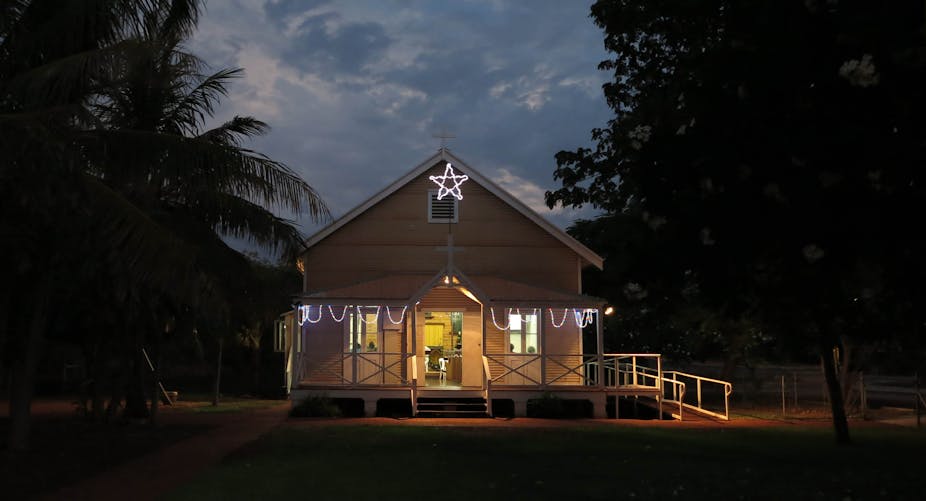Randolph Stow’s To the Islands (1958) is an astonishing novel, a work of poetic skill and political subtlety – and one that is rarely mentioned today.
Its omission from Australian literary syllabuses and absence in contemporary cultural discussions is odd. Why is the 1958 Miles Franklin Award novel and winner of the Australian Literature Society Gold Medal ignored, overlooked or just plain forgotten? Perhaps the subject matter provides a clue.
Set in a remote Anglican mission at the far north-west of Western Australia, contemporary readers are confronted with the fruits of Australia’s racist policies concerning Aboriginal peoples.
Ostensibly, the scenario opposes whites and blacks. But Stow is too intelligent to leave it at that. Trained as an anthropologist, racial differences are treated with sensitivity and care.
There are no shallow or prosaic types but rather flawed and emotionally conflicted characters who struggle with their physical isolation, material poverty and ageing.
The character who grapples most with his demons is Heriot, the protagonist and principal chaplain of the Anglican mission who has lost all faith, especially in himself:
He smiled at himself in the mirror. But it was wrong, the muscles in his face were stiff … And the mirror was broken. Broken, broken. He saw himself as a great red cliff, rising from the rocks of his own ruin. I am an old man, an old man.
Stow’s repetition captures the plaintive tone of Heriot’s internal monologue that sounds like a requiem. Heriot may be a ruined old man but he is not bereft of feeling, or even, as we later find out, compassion.

The drama unfolds once he commits a terrible act of violence against an Aboriginal man. In the belief that he has killed him, Heriot goes walkabout into the wilderness.
His fierce hatred toward the man, who is named Rex, appears to be motivated by racism and superstition. But we learn gradually that the man is in fact his son-in-law. Heriot holds a grudge against Rex because he chooses to believe that he allowed his daughter and grandchild to die in childbirth.
There exists a familial as well as historical hurt between the two men that is revealed incrementally and with a mesmerising grace.
Readers are confronted with an uncomfortable truth – one that involves inter-racial love and sexual bonds. Such relationships were certainly taboo at the time of the novel’s publication, despite their reality – or perhaps because of it.
Although Stow’s novel presents us with challenging social, political and historical issues, it was never denied literary merit. Indeed the power of Stow’s prose is the equal of anyone’s from Patrick White to Christina Stead; it is exquisite in its sparseness, precision and surprising beauty.
The frankness and difficulty of the subject matter is counter-balanced by the splendour of Stow’s memorable turns of phrase. Take for instance the opening sentence, which manages to transform the banality of waking up in the morning into a short poem:
A child dragged a stick along the corrugated iron wall of a hut, and Heriot woke and found the morning standing at his bed like a valet, holding out his daylight self to put on again, his name, his age, his vague and wearying occupation.
This single lyrical sentence tells us many things.
Character and place are established quickly. We also learn that Heriot assumes a daylight identity, which implies that he conceals a nighttime self. Heriot’s horizontal awakening is met by the sharp stance of a vertical sun that forces him out of bed.
He is the sun’s servant. The irony of calling it his valet is not lost. Describing morning as a valet highlights a rare poetic imagination that yokes together heterogeneous things.
The natural world and landscape play a key role in this novel about loss, grief and an unconventional coming of wisdom.
As Heriot roams and struggles through the terrain of remote northern West Australia, his external wanderings transform into a spiritual journey of memory where he is capable of seeing himself as Rex, even to the point of imaginatively living in his body. Through empathy his foe is humanised and given due respect.
The possibility of reconciliation is awakened through Heriot’s imagination. Although Rex and Heriot never meet again, there is a strange harmony forged through the latter’s exertions. His odyssey pushes his mind and body beyond the limits of his individual human suffering.
It is to the islands – a world outside one’s knowledge and body – that Stow’s lead character and novel ushers. Like Heriot, we are challenged to look outside ourselves in thinking of others, and also in finally being at peace with our flawed selves.
This is particularly prescient in modern Australia, which tends to function in ignorance of the ongoing cultural disenfranchisement of Australia’s first peoples.
To the Islands is a deeply moving and compassionate novel whose message and wisdom is still important today, which is why it deserves to be recognised as an important work of Australian literature.
Read more articles in The Case For series.
Are you an academic or researcher? Is there an Australian book or piece of writing – fiction or non-fiction, contemporary or historical – you would like to make the case for? Contact the Arts + Culture editor with your idea.

